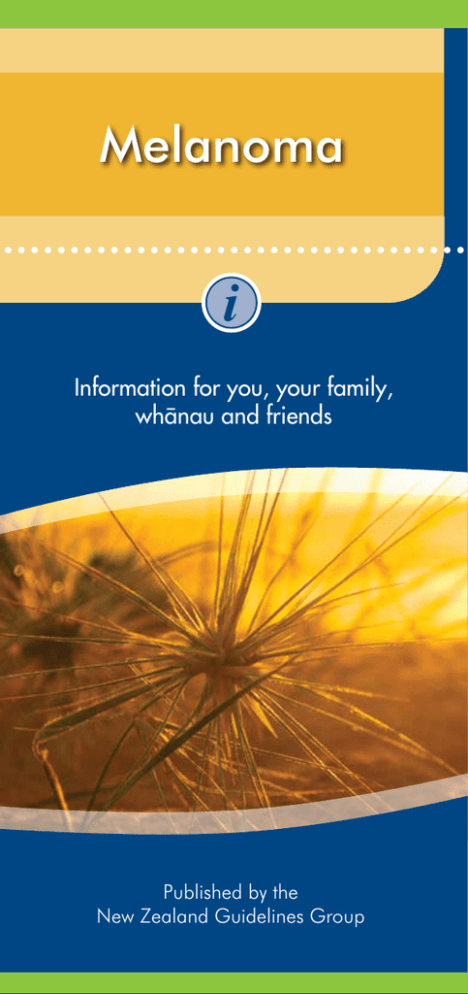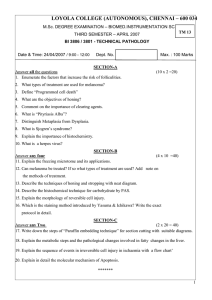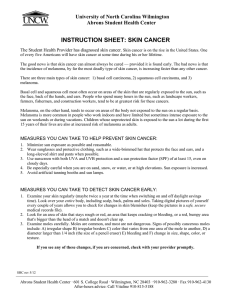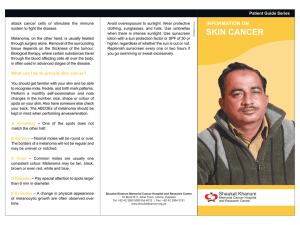Melanoma - Ministry of Health
advertisement

Melanoma Information for you, your family, whänau and friends Published by the New Zealand Guidelines Group Contents About melanoma 1 What is melanoma? 2 What causes melanoma? 3 How can melanoma be prevented? 4 How do I check for melanoma? 5 What should I do if I notice any skin changes? 8 How is melanoma diagnosed? 9 Are some people at more risk of developing melanoma? 10 What if I am at high risk for melanoma? 11 Other common questions about melanoma 12 Further information 14 The information in this brochure is drawn from ‘Clinical Practice Guidelines for the Management of Melanoma in Australia and New Zealand’, 2008, published by the New Zealand Guidelines Group. ISBN (print): 978-1-877509-06-3 ISBN (electronic): 978-1-877509-07-0 About melanoma This booklet is about melanoma and how to check for this serious skin cancer. You may wish to discuss this information further with your family, whänau and your doctor (GP). Did you know? • New Zealand and Australia have the highest rates of melanoma in the world • Melanoma is the fourth most common cancer diagnosed in New Zealand • Mäori and Pacific people have a much lower chance of getting melanoma, but often have thicker (more serious) melanomas • About half of all melanomas are first found by the person themselves • Early identification of a melanoma can lead to earlier and more effective treatment 1 What is melanoma? Melanoma is the most serious type of skin cancer. This is because it can spread rapidly and can be life-threatening if left untreated. Melanoma develops from skin cells called melanocytes. These are found in the deeper layers of the skin and produce a protein called melanin. Melanin protects the skin by absorbing harmful ultraviolet (UV) radiation. There are the same number of melanocytes in dark and fair skin, but the melanocytes in darker skin produce more melanin. People from ethnic groups with naturally darker skin have more protection against UV radiation and so are less likely to get skin cancers, including melanoma. 2 What causes melanoma? Most melanomas are caused by exposure to UV radiation in sunlight. Sun exposure in childhood gives a greater risk of melanoma than sun exposure in later life. There is also a greater risk of melanoma with high doses of sun exposure occasionally (eg, during holiday and recreational activities), than with more continuous sun exposure (eg, daily work outdoors). Tanning booths or sunbeds (solaria) provide exposure to UV radiation, mainly ultraviolet A. There may be a greater risk of melanoma from the use of tanning booths or sunbeds, particularly if they are used before the age of 35 years. Current Australian and New Zealand standards for solaria suggest the use of tanning booths and sunbeds is not appropriate for people with type 1 skin (pale skin with freckles and unable to tan) or for younger people (under 15 years). 3 How can melanoma be prevented? The risk of melanoma is reduced by avoiding sunburn and protecting the skin against harmful UV radiation using physical methods, with the addition of sunscreens. Physical methods of UV protection • shade • broad-brimmed hats • clothing covering the arms, legs and trunk • appropriate sunglasses (close fitting, wrap-around glasses that meet the Australian/New Zealand Standard AS/NZS1067) Sunscreens should not be used as a replacement for physical methods. It is particularly important to use physical methods when UV radiation is highest. In New Zealand, this is between 11am and 4pm during daylight saving months. Further information on prevention is available from www.sunsmart.org.nz Information on sun safety for people who work outdoors is available from ACC at www.acc.co.nz 4 How do I check for melanoma? Check your skin regularly Regular skin checks increase the chance of finding melanoma and other skin cancers at an early stage when they are easier to treat. Check your skin regularly so you will be aware of any changes. If you are concerned about any skin changes you should see your doctor. Where to look Make sure you check your entire body, including skin not normally exposed to the sun. Use a hand-held mirror or ask for help from someone else to check difficult areas (eg, back, neck). Check your: • head, scalp, neck and ears • trunk: front, back and sides • arms, armpits, hands, fingers and nails • buttocks, legs and feet. Although melanomas can occur anywhere on the body (including areas not exposed to the sun), the most common sites are the lower legs for women and the upper back for men. 5 What to look for Look for a new spot or an existing spot, freckle or mole that has changed in colour, shape or size. Sometimes melanomas may be itchy or may bleed but usually there are no symptoms. Some may become raised quickly and catch on clothing. Look out for the ABCDE of melanoma A asymmetry B border Imagine a line down the middle of the spot. Is one half different (not like the other side)? Does the spot have a spreading or irregular edge? C colour Does the spot have a number of different colours in it? D diameter Is the spot growing or changing in diameter or size? E elevation/evolution Is the spot raised? Has it changed since you last noticed it? Images reproduced with the kind permission of the Irish Cancer Society. 6 Look out for nodular melanoma This type of melanoma is not common and is frequently not recognised as melanoma. They are most often found on the head and neck and in older people, particularly men. Nodular melanomas grow very rapidly and require urgent removal. Nodular melanomas are raised, firm and often uniform in colour. Look out for acral lentiginous melanomas This type of melanoma is more common in darker skinned people. Check the soles of your feet, the palms of your hands and under your nails. If you find anything that you are unsure about, show your GP. 7 What should I do if I notice any skin changes? If you find any unusual skin changes you should see your GP. A GP skin examination involves a careful whole-body skin check under good lighting. Your GP may use a dermoscope (a skin surface microscope) to examine spots more closely. Photography, including total body photography, may be used to record the appearance of spots on the skin. Your GP may suggest reviewing some spots at a later date to see if they have changed. 8 How is melanoma diagnosed? If your GP suspects that you have melanoma, a biopsy will be suggested. The biopsy may be done by your GP or you may be referred to a specialist. The GP or specialist gives you a local anaesthetic to ‘numb’ the skin and then uses a scalpel to remove the suspected melanoma and some surrounding tissue. The tissue that is cut out is sent to a pathology laboratory for examination under a microscope. It sometimes takes about a week to get the results from the laboratory. During this waiting time, it is often helpful to talk about your concerns with a family member or a close friend. 9 Are some people at more risk of developing melanoma? The chance of developing melanoma increases with age. Although most melanomas are found in people aged 50 years or older, melanoma is reasonably common in younger age groups (especially people aged between 25 and 39 years). Melanoma is rare in children. Some people are at increased risk or high risk for developing melanoma due to factors such as their skin type or family history. Factors that are known to increase your risk or which make you at high risk for melanoma are listed in the box. Are you at increased risk for melanoma? These are important risk factors: • skin colour (light versus medium or dark skin) • hair colour (red or blond hair versus black hair) • skin type (burn easily, never tan) • skin damage due to sunburn. 10 Are you at high risk for melanoma? These are important risk factors: • a personal history of melanoma • a family history of melanoma in a first-degree relative (parent, brother or sister, child). This risk is higher if more than one relative had a melanoma, if they were young at the time or if one relative had more than one melanoma • large number of moles on your skin (more than 50 moles) • atypical (dysplastic) ‘funny looking’ moles on your skin • a personal history of a previous non-melanoma skin cancer. What if I am at high risk for melanoma? If you are at high risk for melanoma you need specific advice from your GP on what methods of protection and checking of your skin is best for you, including how you can recognise and record suspicious skin changes. Partners or carers should also receive this information. You may be encouraged to have regular checks by your doctor, with 6-monthly whole-body skin examinations. Your doctor may use dermoscopy and total body photography to help in assessing spots and monitoring your skin over time. 11 Other common questions about melanoma How is melanoma treated? Treatments for melanoma include surgery, radiotherapy and chemotherapy (drug treatment). The best treatment for a particular melanoma depends on the type and stage of melanoma (how far it has spread) and the person’s general health. Treatment plans are made for each individual after discussion between the doctor and the person. Most people will only need surgical removal of the melanoma. The melanoma is cut out, as well as a small area of normal-looking skin around the melanoma. If the melanoma is found at an early stage, the whole melanoma is removed during the biopsy. A second procedure may be required to remove a wider area of surrounding skin. This is done to make sure all the melanoma cells have been removed. 12 What support is available for people diagnosed with melanoma? In addition to the support provided by family and friends, organisations such as the Cancer Society of New Zealand (0800 226 237) offer information and support services for people with cancer, including melanoma. The Cancer Society also has an information brochure for people who have been diagnosed with melanoma at www.cancer.org.nz 13 Further information Further information on melanoma is available from: • your doctor (GP) • Cancer Society of New Zealand www.cancer.org.nz; Oncology (cancer) Information nurse 0800 CANCER (0800 226 237) • www.sunsmart.org.nz for information on prevention • www.acc.co.nz for information on sun safety for outdoor workers – search on ‘sun safety’ • visiting the New Zealand Guidelines Group website www.nzgg.org.nz for the detailed guideline ‘Clinical Practice Guidelines for the Management of Melanoma in Australia and New Zealand’ Copies are available free from: • Wickliffe 04 496 2277 Order No. HP: 4699 • www.nzgg.org.nz – click on ‘Consumer Resources’ then ‘Melanoma’ • info@nzgg.org.nz The New Zealand Guidelines Group wish to thank all those who contributed in the development of this brochure. This resource has been funded by the Ministry of Health. © 2008 Ministry of Health





